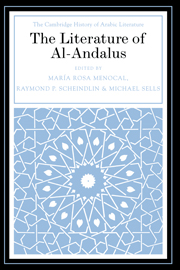Book contents
- Frontmatter
- 1 Visions of al-Andalus
- PART I THE SHAPES OF CULTURE
- PART II THE SHAPES OF LITERATURE
- 7 The muwashshah
- 8 The maqama
- 9 The qasida
- The Aljafería in Saragossa and Taifa spaces
- PART III ANDALUSIANS
- PART IV TO SICILY
- PART V MARRIAGES AND EXILES
- PART VI TO AL-ANDALUS, WOULD SHE RETURN THE GREETING
- Index
The Aljafería in Saragossa and Taifa spaces
from 9 - The qasida
Published online by Cambridge University Press: 28 May 2012
- Frontmatter
- 1 Visions of al-Andalus
- PART I THE SHAPES OF CULTURE
- PART II THE SHAPES OF LITERATURE
- 7 The muwashshah
- 8 The maqama
- 9 The qasida
- The Aljafería in Saragossa and Taifa spaces
- PART III ANDALUSIANS
- PART IV TO SICILY
- PART V MARRIAGES AND EXILES
- PART VI TO AL-ANDALUS, WOULD SHE RETURN THE GREETING
- Index
Summary
Beginning with the fitna (civil war) (c. 1010), early Taifa literary and visual culture directly engage the Cordoban court, through either emulation or manipulation of topoi. Surviving palatial spaces date largely to a second period, however, which begins around 1040. These later Taifa spaces can be divided into two categories: settings for official events that affirmed the ruling dynasty through traditional displays of riches and “marvelous things,” and spaces that served as the backdrops against which sovereign and nudamāʾ (drinking companions) indulged in the arcane excesses of the royal majlis (chamber). No complete official spaces survive, but the majlis is represented in the central zone of the Aljafería at Saragossa.
In accounts of official and private palatial spaces, two distinct visual languages might be seen as paralleling the two Taifa approaches to space. In a description of a complex of pavilions and rooms constructed by al-Maʾmūn of Toledo, Ibn Jabir communicates the orchestrated nature of the celebration in a matter-of-fact tone. The features that most attracted the author’s attention were the lavish ornamentation and textiles in salons and pavilions, and their formality and exclusivity. Accounts of “lifelike” ornament and opulent use of rare and luxurious materials – carefully listed in texts along with their provenance and ostentatiously displayed – are characteristic of the ornamental idiom used to address the conservative audience (quwwād,fuqahāʾ, and other upholders of the Maliki school) for which these official spaces were created.
- Type
- Chapter
- Information
- The Literature of Al-Andalus , pp. 233 - 234Publisher: Cambridge University PressPrint publication year: 2000
- 1
- Cited by



